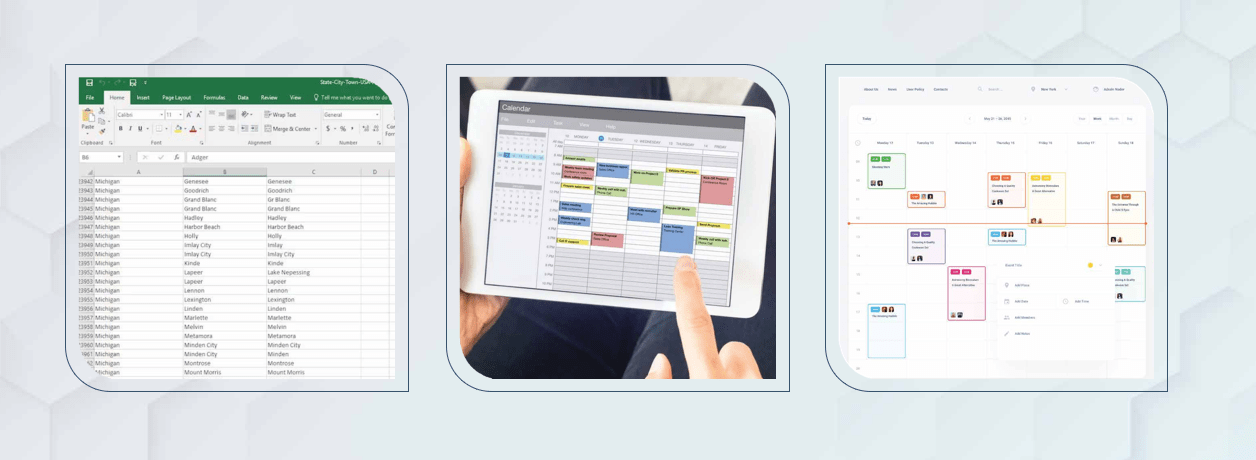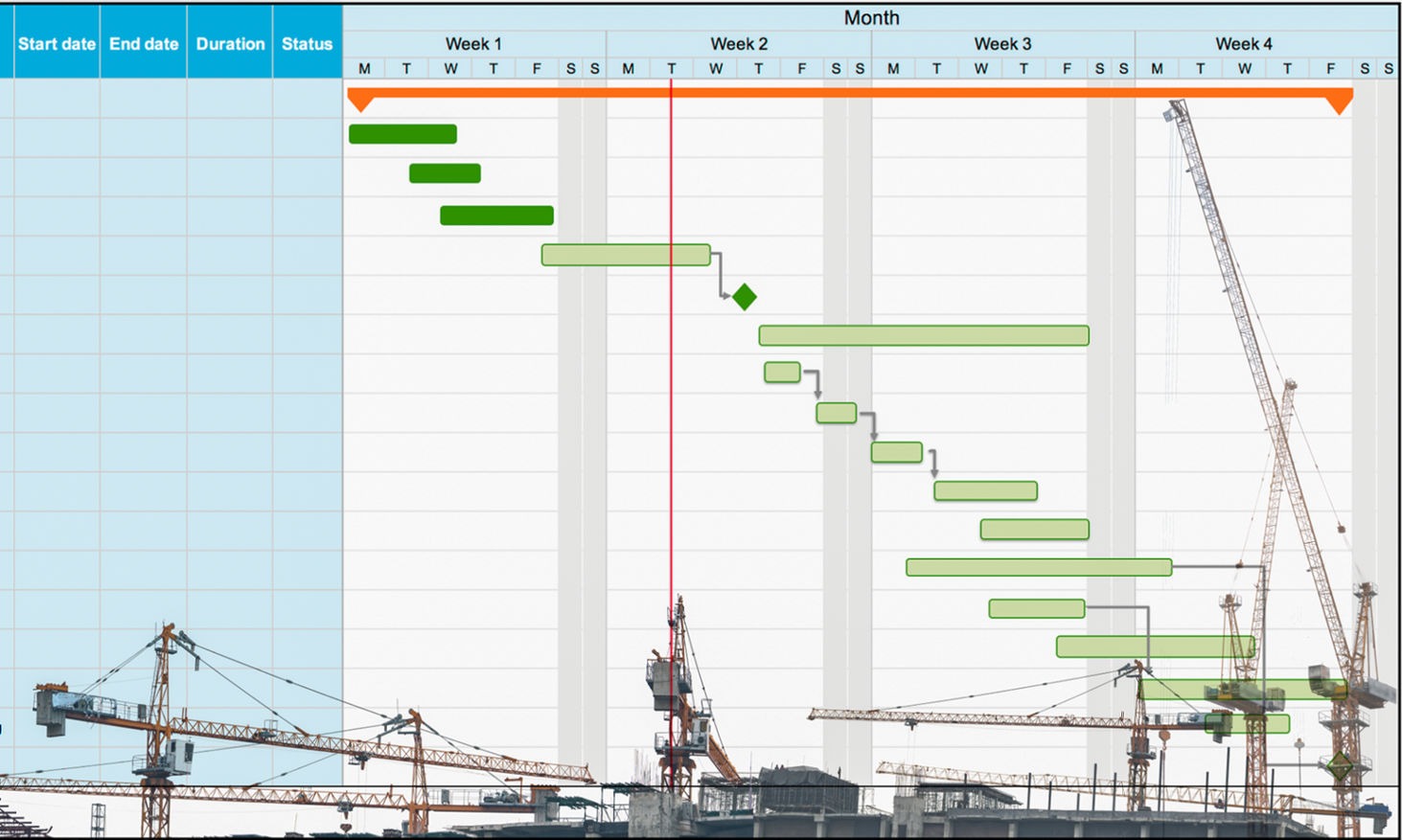When it comes to construction projects, efficient scheduling is critical to success. From managing timelines to ensuring resource availability, construction scheduling plays a vital role in project management. In this article post, we’ll explore the key aspects of construction scheduling, including its importance, best practices, and tools to help streamline the process.
Whether you are an experienced project manager or new to the industry, understanding the construction schedule is essential to achieving project goals and delivering quality results.
What is Construction Scheduling in Capital Projects?
Construction Scheduling involves organizing essential activities within a capital project. It serves as a blueprint of how the project is going to be executed. It does not only organize activities but also establishes overall project timelines, including all important project milestones. It is the project manager’s responsibility to monitor the schedule closely to ensure on-track project execution.
A construction schedule consists of various vital elements such as deliverables, resource management, task assignments, durations, deadlines, dependent tasks, budget, and the associated costs. It is also important to note that the construction schedule is flexible. It means that the project managers can easily review and revise it as the project progresses.
Certainly, creating a construction schedule requires a significant amount of time and effort. It is paramount to take the right steps diligently towards creating as detailed and accurate schedule as you can. It also helps you in mitigating potential risks. This meticulous approach is critical for effective construction project management, ensuring a smoother and successful project execution.
However, creating a construction schedule manually can be challenging and time-consuming, especially for complex and large-scale projects. That’s why many construction managers and teams use construction scheduling software to plan, monitor and execute their projects according to their needs.
Construction scheduling software is a type of software that helps users create, update and share construction schedules with stakeholders and team members. It can also offer various features and benefits, such as online Gantt charts, real-time dashboards and timesheets, project reporting tools, intuitive interface and customer support.
Importance of Construction Scheduling
Preparing a construction schedule is undoubtedly the most critical factor in making sure that your project is completed within time and budget and to the client’s satisfaction.
Effective project scheduling benefits the entire project, right from initiation to execution. Let us explore how it can enhance your overall construction project management.
Resource Management
When resources are managed efficiently, not only the project is completed within the estimated time and budget, but it also has far-reaching positive effects. Firstly, working in an organized and predictable environment boosts the team’s morale. Secondly, it will foster better relationships among team members and stakeholders. It plays a significant role in maximizing your profitability as your wastage and inefficiencies are minimized. Lastly and most importantly, it results in stakeholder satisfaction as timely and within-budget project completion instills confidence and trust in the organization’s capabilities.
Provides Blueprint
It presents a series of tasks, enabling the project manager to understand which activities they should focus on and anticipate the upcoming tasks that need preparation. This helps project managers to stay organized and plan their work effectively.
Asset Allocation
A construction schedule helps managers to assign workers, equipment, and materials efficiently, reducing downtime. It also ensures that the project is completely within the estimated time and budget through proper planning and scheduling.
Budget Control
Construction Scheduling allows project managers to assign realistic timelines for each activity within a project. It helps identify important paths, dependencies, and potential issues, enabling the managers to proactively manage project delays or risks. By sticking to the schedule, managers can help control costs and minimize budget overruns.
Quality Control
A well-planned construction schedule includes specific time slots for inspection, testing, and quality control activities at different project stages. It makes sure that the required checks and balances are taken care of to maintain the desired quality standards and adhere to regulatory requirements.
Types of Construction Schedules

1. Critical Path Method (CPM)
It distinguishes critical and non-critical tasks in order to prevent project scheduling problems and potential bottlenecks. Critical Path Method (CPM) works well for projects consisting of numerous activities that interact in a complex manner.
2. Project Evaluation and Review Technique (PERT)
In the realm of project management, the Project Evaluation and Review Technique (PERT) is used to estimate the time it takes to complete a specific task or activity. This system helps in the proper scheduling and coordination of all tasks within a project lifecycle.
PERT is crucial for keeping track of the project’s progress and making sure everything is moving as per the schedule. Developed by the US Navy in the 1950s, PERT was initially brought to use for managing the Polaris submarine missile program, showcasing its effectiveness in managing complex projects.
3. Gantt Charts
In construction management, project schedules have many different phases and milestones throughout the construction management process that need to be monitored carefully. Gantt Charts are valuable tools as they visually represent the progress of various tasks and the overall project timeline. This simplifies the planning and scheduling process, ensuring effective project management of the entire capital project.
4. LOB (Line of Balance)
The LOB method, a form of linear scheduling, ensures that project activities are balanced. This means tasks can be carried out continuously, maintaining a steady production rate. This approach guarantees that each activity in the project is performed without interruptions, allowing the project to meet its goals as planned.
5. Quantitative Scheduling
Simply referred to as Q Scheduling, the Quantitative Scheduling method shows resource quantities as well as when and where resources are required. It is a unique scheduling method in construction management because it links task orders to resource costs.
6. Resource Scheduling
Scheduling is a vital aspect of project management, irrespective of the project type. This becomes even more critical when resources are limited or carefully managed. In situations where a project’s deadline relies heavily on resource availability and work capacity, project managers often refer to this as resource-constrained scheduling. This method ensures efficient allocation of resources, making it essential for successful project completion within constraints.
7. Last Planner System
The Last Planner System promotes the establishment of a predictable workflow among various parties involved to achieve targeted goals. The LPS detects potential hurdles and addresses the issue before they slow down the flow.
What Should a Construction Project Schedule Include?
Streamlined construction schedules includes:
- Deliverables: Clearly defined project outcomes.
- Resource Management: Efficient utilization of manpower and materials.
- Asset Allocation: Optimal distribution of equipment and resources.
- Tasks: Well-defined project activities.
- Dependent Tasks: Sequenced activities with interdependencies.
- Task Duration: Precise timelines for each activity.
- Deadlines: Time-bound milestones for project completion.
- Budget and Costs: Financial aspects, including associated expenses.
By refining these elements, the construction schedule achieves enhanced efficiency and effectiveness.
Steps to Create a Construction Schedule
Now that we know what a construction schedule is and why it is important for a project owner to create a well-planned schedule, it is time to dive deep into how a construction schedule is created. Here are the five steps to create a robust construction schedule:
1. Get Info and Tools
The first crucial step towards the creation of a construction schedule is to gather as much information as you can about the project and the stakeholders involved. Clearly define what needs to be done and what is your team’s requirements. If you are feeling unsure about where to start, a good starting point could be reaching out to the subcontractors involved and inquiring about their requirements and explore the utilization of construction scheduling software to facilitate this process. This stage lays a strong foundation for a well-planned and organized project schedule.
2. Collect and Prioritize Tasks
Every step that gets you closer to the completion of a project is called a ‘task.’ To perform them well, you should divide your tasks into smaller parts and clearly define them. These tasks are the building blocks of your schedule. It is crucial to gather, prioritize, and assign them properly to achieve project success.
3. Add Duration
After gathering the information and assigning all necessary tasks for the successful execution of the project, it’s time to set start and end dates for each task. Estimating how long each task will take helps you understand the overall project duration and plan your resources accordingly.
4. Allocate and Execute
Before the construction begins, it is important to assign tasks. Clearly defined roles and responsibilities reduce confusion and ensure that everyone is clear about what they have to do. This clarity makes the team and contractors more accountable and focused on their work. Once the tasks are assigned, the schedule is ready for real-world action. It is important to balance the resources and avoid overloading any team or stakeholder.
To carry out the project successfully, it’s crucial to equip your team with the right skills, tools, and materials. They must also follow safety and environmental rules. Monitoring progress using tools like KPIs, dashboards, and reports is important. This helps you compare how the project is going with the initial plan and expectations.
5. Review
A schedule should never be rigid and unchangeable. It needs to be adaptable and open to changes based on the updated information. It requires regularly reviewing completed tasks to correct any issues and minimize risks. Monitor and review your schedule periodically to see how things are going and to handle any problems that may arise in the future.
How Does OnIndus Contribute to Improving Construction Scheduling?
Navigating the initial stages of construction projects can often be challenging for many companies due to the numerous options available. Choosing the right methods, integrating them into existing workflows, and ensuring universal adoption – all of this, even when dealing with just one new methodology, let alone multiple.
The solution to this problem is OnIndus. We have a system in place that efficiently organizes construction scheduling. Our team of experts helps project owners and companies gain a competitive edge and better control over all their construction projects by using construction scheduling software. We make it easy to plan, execute, and successfully complete projects from start to finish.
Conclusion
Time is a valuable resource, and effective construction projects, backed by diligent planning and detailed schedules, can help you save both time and money. The additional effort invested in these aspects at the project’s outset will prove highly beneficial. You’ll witness the significant advantages they bring in terms of smoother project delivery, ensuring projects are completed within the allocated time and budget.
FAQs
1. What should a construction schedule include?
A construction schedule should include specific task details, start and end dates, task dependencies, required resources, and considerations for potential delays, inspections, and testing phases to ensure effective project management and timely completion.
2. How to create a construction schedule?
To create a construction schedule, outline project tasks, start and end date, identify task dependencies, allocate resources, account for potential delays, and regularly monitor progress to ensure timely completion.
3. How to keep a construction project on schedule?
To keep a construction project on schedule, monitor progress closely, address delays promptly, and maintain effective communication among team members. Adapt the schedule as required based on the project requirements and unforeseen challenges.
4. What is the construction milestone schedule?
A construction milestone schedule outlines key project milestones, indicating specific dates when significant phases or goals should be achieved providing a roadmap for project progress and completion.

